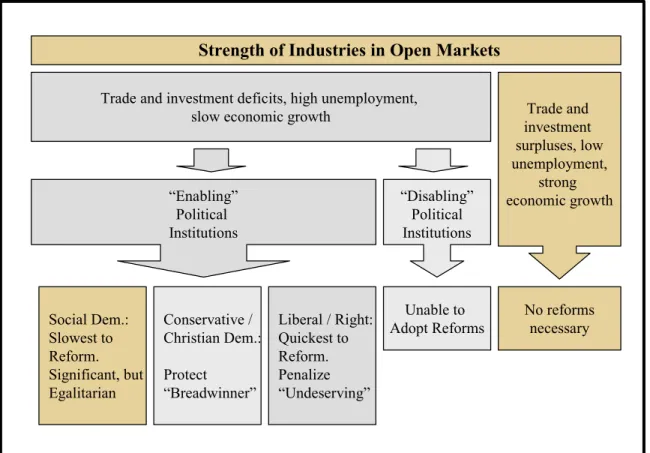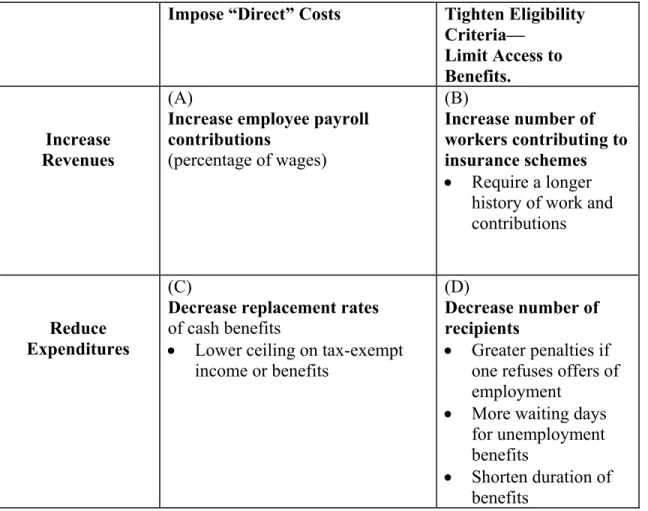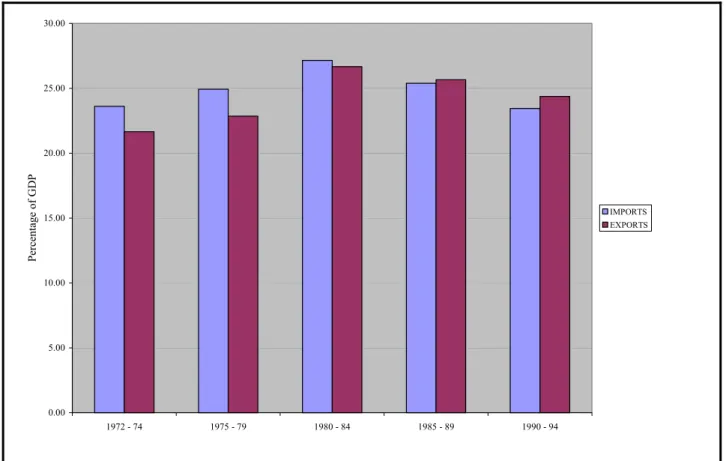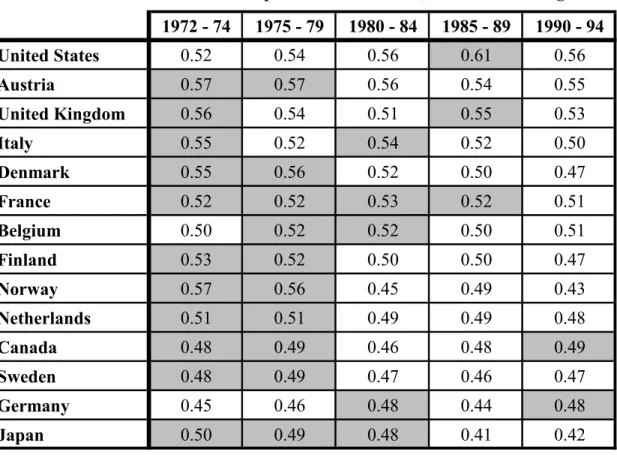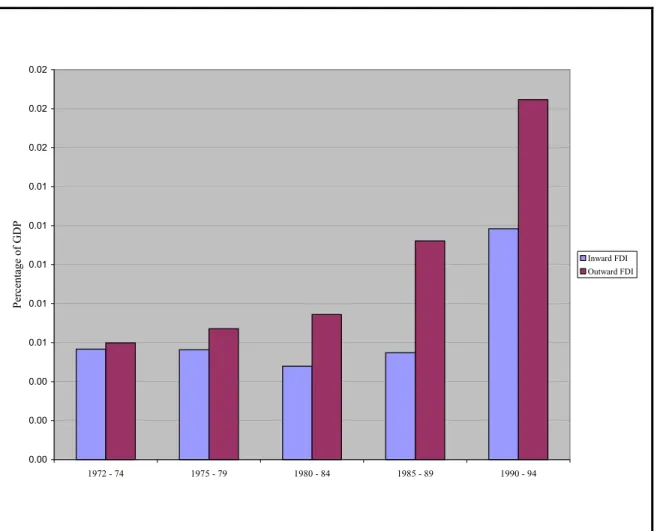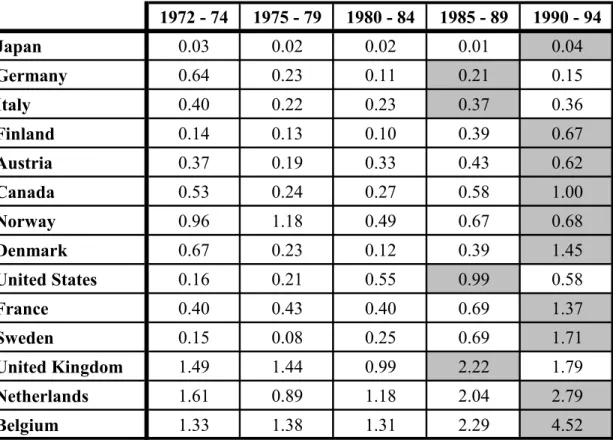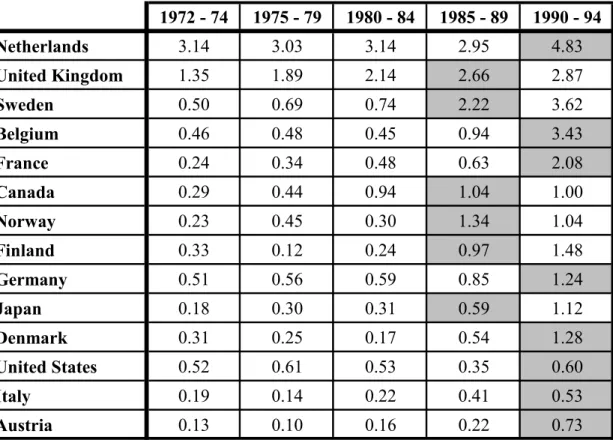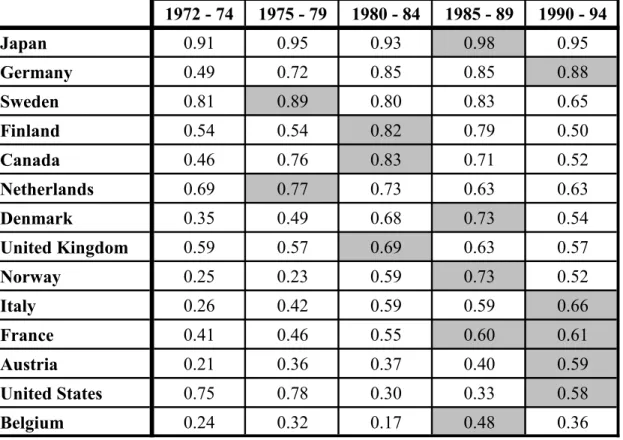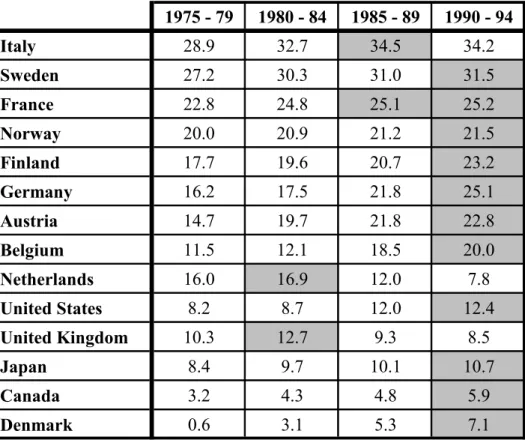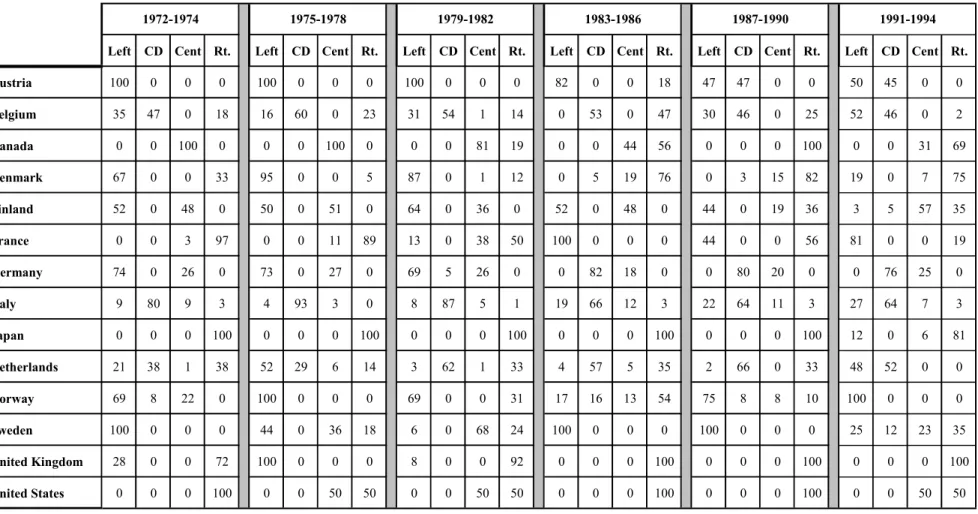GLOBAL ECONOMICS, DOMESTIC POLITICS, AND REFORMS OF SOCIAL INSURANCE PROGRAMS IN ADVANCED CAPITALIST COUNTRIES
By
Stephen Craig Ammon
Dissertation
Submitted to the Faculty of the Graduate School of Vanderbilt University in partial fulfillment of the requirements for
the degree of
DOCTOR OF PHILOSOPHY in
Political Science May, 2002 Nashville, Tennessee
Approved:
Professor Donna L. Bahry Professor M. Donald Hancock
Professor Kurt G. Weyland Professor Bruce I Oppenheimer
Professor Robert A. Margo
TABLE OF CONTENTS
ACKNOWLEDGEMENTS AND DEDICATION ...i v
LIST OF TABLES ...v
LIST OF FIGURES ...vii
Chapter I. GLOBALIZATION AND THE WELFARE STATE: REVIEW OF THE LITERATURE... 1
Introduction... 1
Existing Literature and its Key Assumptions ... 3
Shifting Trends in Trade and Investment in the Global Market ... 5
The Compensation Thesis and the Efficiency Thesis ... 6
The Need for More Research... 10
Outline of the Dissertation ... 10
II. LESSONS LEARNED FROM CURRENT RESEARCH... 14
Introduction... 14
Key Assumptions Borrowed from the Literature... 15
III. REFINEMENT OF THE EFFICIENCY THESIS... 23
The Link between Globalization Welfare State Programs ... 23
The focus on Social Insurance ... 26
Other Sources of Reforms not Addressed Here... 30
The Enabling Influence of Political Institutions ... 31
The Influence of Labor Unions on Economic and Social Policies ... 34
The Influence of Partisanship ... 36
Globalization and Social Insurance: A Curvilinear Relationship... 38
An Alternative Measure of Welfare Effort ... 40
Hypotheses... 43
IV. GLOBALIZATION AND RETRENCHMENT REVISITED... 46
Introduction... 46
Source of Data and Methods... 46
Page
The Influence of Intervening Political Variables... 57
Unemployment and Economic Growth ... 58
Specific Economic Trends in Each Country... 63
The Influence of Institutions on the Feasibility of Reforms ... 66
Predictions for Reforms ... 67
Policy Outcomes ... 69
Regression Results... 74
V. PARTISANSHIP AND PROTECTING OF TRADITIONAL VALUES... 124
Introduction... 124
Options that are Market Conforming... 124
Traditional Partisan Values... 126
Predictions for Reforms Based on Traditional Partisan Values... 128
Specific Reforms of Social Insurance Programs ... 133
VI. CONCLUSION... 151
Introduction... 151
Contradictions in the Literature ... 152
The Contribution of this Dissertation ... 153
Limitations of This Research... 157
Avenues for Further Research ... 158
APPENDIX... 160
BIBLIOGRAPHY... 186
NOTES ... 194
ACKNOWLEDGEMENTS AND DEDICATION
I am grateful to my committee members for all of their input and guidance throughout the process of writing this dissertation. I am also indebted to Professor Duane Swank for sharing his data on state structures and partisanship. My dataset on which all of my findings are based also incorporates data on labor unions from the Miriam Golden, Peter Lange and Michael Wallerstein dataset, as well as data on demographic and labor market trends from the Evelyne Huber and John D. Stephens “Comparative Welfare State Dataset.” I am thankful to all of these
scholars for making their data publicly available on their respective websites.
Writing this dissertation has been a tremendous challenge, but also a source of much enjoyment for me. Still, most of this writing took place on nights and weekends – time I would have otherwise spent with my wife, Kathryn, and my children, Evan and Vaughn. It was only with their unending patience and support that I was able to finish. Therefore, I dedicate this dissertation to the three of them.
LIST OF TABLES
Table Page
1. Imports, Percentage of GDP, Five Year Averages ... 84
2. Exports, Percentage of GDP, Five Year Averages ... 85
3. Ratio of Imports to Total Trade, Five Year Averages ... 86
4. Inward Foreign Direct Investment, Percentage of GDP, Five Year Averages ... 88
5. Outward Foreign Direct Investment, Percentage of GDP, Five Year Averages ... 89
6. Ratio of Outward Foreign Direct Investment to Total Foreign Direct Investment, Five Year Averages... 90
7. Total Employer Contributions for all Social Insurance Programs, Five Year Averages.. 91
8. Proportion of Cabinet Government Occupied by Left, Christian Democratic, Secular Center, and Right Parties ... 92
9. Indices of Political Institutional Configurations: Inclusive Electoral Institutions, Decentralization of Government Authority, and Social Corporatism ... 93
10. Unemployment Rates, Five Year Averages... 94
11. Real Economic Growth Rates, Five Year Averages... 95
12. Regression Analysis for Unemployment Rates ... 96
13. Regression Analysis for Real Economic Growth Rates ... 98
14. Predictions for Reform... 100
15. Index of Reforms ... 115
16. Regression for Unemployment Insurance Adjusted Replacement Rates ... 116
17. Regression for Old Age Pensions Adjusted Replacement Rates ... 118
18. Regression for Disability Pensions Adjusted Replacement Rates... 120
19. Regression for Sickness Benefits Adjusted Replacement Rates... 122
20. Comparison of Gross Replacement Rates for Unemployment Benefits, Workers with 2/3 Average Wages vs. Average Wages ... 145
21. Program Summary for Unemployment Benefits ... 146
22. Old Age Pensions, Gross Replacement Rates for Workers with Minimum Contributions, Half of Maximum Contributions, and Maximum Contributions ... 147
23. Program Summary for Old Age Pensions... 148
24. Program Summary for Disability Pensions... 149
25. Program Summary for Sickness Benefits ... 150
LIST OF FIGURES
Figure Page
1. The Relationship Between Trends in Globalization and Reforms of Social Insurance.... 38
2. Options for Reforms ... 42
3. Imports versus Exports, Percentage of GDP, Five Year Averages... 83
4. Inward versus Outward Foreign Direct Investment, Five Year Averages for Fourteen Countries... 87
5. Adjusted Replacement Rates for Austria, 1973-1995... 101
6. Adjusted Replacement Rates for Belgium, 1973-1995... 102
7. Adjusted Replacement Rates for Canada, 1973-1995 ... 103
8. Adjusted Replacement Rates for Denmark, 1973-1995 ... 104
9. Adjusted Replacement Rates for Finland, 1973-1995 ... 105
10. Adjusted Replacement Rates for France, 1973-1995 ... 106
11. Adjusted Replacement Rates for Germany, 1973-1995 ... 107
12. Adjusted Replacement Rates for Italy, 1973-1995 ... 108
13. Adjusted Replacement Rates for Japan, 1973-1995 ... 109
14. Adjusted Replacement Rates for Netherlands, 1973-1995 ... 110
15. Adjusted Replacement Rates for Norway, 1973-1995 ... 111
16. Adjusted Replacement Rates for Sweden, 1973-1995... 112
17. Adjusted Replacement Rates for the United Kingdom, 1973-1995 ... 113
18. Adjusted Replacement Rates for The United States, 1973-1995... 114
CHAPTER I
GLOBALIZATION AND THE WELFARE STATE: REVIEW OF THE LITERATURE
INTRODUCTION
The comparative literature has given much attention to the “crisis” of the welfare state, the inability of advanced capitalist states to maintain generous social welfare programs and ensure continued economic growth (Kitschelt 2001; Huber and Stephens 2001; Pierson 2001;
Schwartz 2001; Swank 2001, 1998; Hicks 1999; Clayton and Pontusson 1998; Garrett 1998).
Especially with the decline in trade barriers since the 1970s, the tensions between these two goals have appeared ever more pronounced (Rodrik 1997, Rhodes 1996). The argument claims that social welfare and insurance policies that redistribute earned incomes through taxes and transfer payments undermine the goals of economic efficiency, capital accumulation, and
economic growth.1 At the micro-economic level, generous social welfare and insurance benefits are assumed to discourage people from working, and this reduces aggregate levels of production and growth. At the macro-economic level, payroll taxes and corporate income taxes divert profits from reinvestment, thereby reducing aggregate levels of capital necessary for economic growth. These arguments would apply even to countries in which outward foreign direct investment is limited. In open markets for goods and services, some scholars claim that these taxes further threaten economic growth by undermining the competitiveness of domestic industries. First, because these taxes diminish profits, they render industries less attractive to foreign investors. Second, because employers’ payroll taxes increase labor costs, the resulting increase in the prices of their products dampens demand for them. As a result, many analysts predicted that welfare programs would be cut in order reduce production costs, increase investment, and restore economic growth.
However, research to date has been contradictory. Conclusive evidence that welfare state expenditures do threaten competitiveness is still lacking.2 There is disagreement over the nature of welfare state policy changes as well. Some analysts find little, if any, adjustment in welfare programs, while others find substantial contraction. Further, those who do find evidence of welfare retrenchment disagree about the causes. For some, shifts in domestic labor markets have produced high rates of unemployment and slowed economic growth, which in turn have driven
reductions in benefits. For others, increasing numbers of benefit claimants, such as old age pensioners and single mothers, have been the source of changes in welfare programs. So far, there is little evidence to support the claim that the need for competitive industries in
increasingly integrated markets has prompted these reforms.
Thus, there is little agreement on whether and why the crisis of the welfare state has led to retrenchment. My aim here is to reassess the debate. I will show that many advanced capitalist countries did adopt reforms to limit benefits, and that these reforms were more pronounced where the state faced deficits in trade and foreign direct investment, worsening unemployment and weak economic growth. Globalization did have an impact, but in a different way than is assumed in much of the literature. Specifically, I show that trends in globalization are associated with expansion of benefit programs to a point, but as these trends become more pronounced they are associated with reforms that reduce benefits. I will further show that political institutions traditionally associated with rising benefits actually facilitate these reforms.
Finally, the influence of government partisanship on the incidence of reform should be weaker than the influence of political institutions. However, where reforms do occur, partisanship should be an important factor in determining specific policy outcomes that preserve traditional interests.
I assess developments in social insurance programs in fourteen advanced capitalist countries (hereafter OECD countries) for the period 1973 to 1995. Through at least the 1970s, the economies of advanced capitalist countries were still quite strong and the costs of welfare state programs were manageable. Therefore, despite these argued tensions between economic growth and welfare state programs that redistribute incomes, neither constituents nor
policymakers had to make difficult choices between these two goals. In most OECD countries both welfare benefits and the taxes that fund them rose at the same time that healthy levels of economic growth were secured. However, as global market integration proceeds, the tensions between economic growth and income redistribution should become more pronounced. Given that the literature has not fully explored this relationship in the context of increased global market competition, a reexamination of this relationship is needed.
EXISTING LITERATURE AND ITS KEY ASSUMPTIONS
All social welfare states serve at least four objectives that mitigate social and economic problems that are inevitable byproducts of capitalism. They encompass several policies intended to alleviate both poverty and income inequality that inhere in capitalist labor markets.3 They also counter market inefficiencies that discourage or prevent individuals from entering the labor market. Finally, welfare states spread the risk of investment in human capital (Barr 1992;
O’Connor 1973). Therefore, these programs receive widespread public support because they significantly improve the economic welfare of many benefit recipients.
Some comparative scholars have long argued that contradictions that inhere in the modern welfare state threaten its survival (Offe 1984, Gough 1979, O’Connor 1973). In capitalist production, owners of capital will benefit when competition among workers for
employment drives down wages and increases profits. While workers are disadvantaged vis a vis owners of capital in the market, their numbers grant them an advantage in the democratic
policymaking process. Laborers can elect policymakers who will increase taxes and social welfare and insurance benefits that will redistribute earned incomes. But these taxes divert profits from future investment, reducing demand for labor and threatening economic growth. So in serving the workers’ short-term interests by redistributing incomes, the welfare state threatens the long-term economic interests of both owners and capital and laborers alike. Despite the soundness of this logic, advanced capitalist countries continued to expand their social welfare programs even while achieving solid economic growth. Therefore, rather than questioning whether the modern welfare state would survive, the comparative literature turned its attention to the influence of interest groups, government partisanship, and political institutions in
determining the pace and character of welfare state expansion.
Early explanations for the development of welfare states among advanced capitalist countries were almost devoid of politics. Functional / structuralist theories claimed that the process of modernization is positively correlated with growth of social expenditures (Flora and Alber 1981; Wilensky 1975). This theory puts forth a functionalist argument, claiming that the expansion of social welfare policies reflects the state’s response to increased “need” among citizens (Esping-Andersen 1990).
Power resources theorists rejected functionalist arguments linking economic development
distribution of power among key political groups and social classes caused changes to social welfare policies (Wennemo 1992; Hicks and Swank 1992; Korpi 1985; Castles 1982; Cameron 1978).4 Laborers seek to expand welfare state programs as long as their post-tax, post-transfer incomes increase. In contrast, owners of capital seek to prevent increases in taxes that decrease profits and divert income from future investment. These assumptions coincide with those
predicting the crisis of modern welfare states. However, power resources theorists predicted that policymakers would serve the interests of laborers, given their numbers, organization, and their ability to influence election outcomes. In fact, several power resources theorists produced evidence showing that differences in labor union strength is the strongest predictor of welfare state expenditures, the range of programs covered, and eligibility criteria (Kangas 1991, Myles 1989; Olsen 1988; Stephens 1979, Korpi 1980, Hicks 1991).
Recent efforts to refine power resources theory focus on the ways in which state structures influence balance of power among competing groups as well as policymakers’
incentives (Swank 2001; Huber and Stephens 1998; Schwartz 1994; Immergut 1992). Rather than focusing on the degree to which constituent groups can take advantage of electoral rules to ensure that their interest are represented in the policymaking process, this “state structure”
literature focuses on the influence of the policymaking process itself. This literature
acknowledges that, in addition to the numbers and organization of parties and interest groups, state structures determine their opportunities to influence policymaking process, opportunities that translate into political power (Crepaz 1998; Birchfield and Crepaz 1998). These scholars found that the extent to which political institutions encourage cooperative versus competitive policy processes is also a strong predictor of welfare policy outcomes.
Finally, the “regime theory” literature posits that variations in demographics, economic strength, or labor union mobilization cannot fully explain variations in the composition of welfare states. Instead, this theory argues that critical historical and political determinants
“institutionalize” relationships among citizens, the state, and the market (Esping-Andersen 1990;
Huber, Ragin, and Stephen 1993). Social welfare programs, their benefits, and the extent to which they redistribute incomes vary systematically according to these institutionalized
relationships. This explains why states with similar political institutions or labor union strength in recent decades have very different policies, emphasizing different objectives.
The theories cited above present differing viewpoints on the sources of political influence granted to laborers and owners of capital. However, each of these theories assumes that the electoral laws and policymaking institutions that grant laborers influence in the policymaking process have translated into political power vis a vis employers and owners of capital in many OECD countries. As a result, welfare benefits and aggregate expenditures, as well as the taxes that fund them, grew in these countries for much of the Post- World War II era.
SHIFTING TRENDS IN TRADE AND INVESTMENT IN THE GLOBAL MARKET
Most OECD countries have historically adopted policies that limited trade and foreign direct investment in order to protect their industries from competition from imports and ensure ample supplies of capital investment. However, as evidence of increasing faith the doctrines of liberal economic principles, policymakers began in the 1970s to either modify or repeal these policies in efforts to stimulate lagging economic growth. According to these principles, all countries would benefit from specializing in industries in which they have a comparative
advantage and trading with other countries for all goods that they don’t produce. A country has a comparative advantage when its opportunity cost of producing that good is lower than the
opportunity cost that other countries would incur. As comparative advantage is determined by opportunity costs, and not actual costs, all countries will have a comparative advantage in the production of some goods, even if the actual cost of production is higher than in other countries.
The process of market integration proceeded slowly and unevenly across countries, and most countries’ markets for goods and capital are still not completely integrated. They were certainly less integrated in the early 1980s, even after many legal barriers were dismantled. This is largely due to the presence of de facto barriers to trade and investment such as transportation costs, differing standards of quality and safety, environmental regulations, and taxes. The argument that all countries will benefit from specialization, trade, and mobile capital starts to unravel when these de facto barriers to trade and investment are taken into account. These barriers were particularly relevant to trade and investment between OECD and non-OECD countries because until recently the latter group lacked the human capital and infrastructure needed for production and transportation of high quality goods. OECD countries have, therefore, traditionally imported limited quantities of goods from non-OECD countries while exporting large quantities of goods to those countries. Also as a result of these barriers, foreign direct
investment was relatively uncommon either among OECD countries or between OECD and non- OECD countries through at least the early 1980s.
In the late 1970s, these de facto barriers to trade and foreign direct investment (FDI) began to disappear. As a result, total volumes of both international trade and FDI increased throughout the 1980s and 1990s. Most notably, newly industrialized countries (NICs) began producing goods that met higher quality and safety standards and could compete in the world market with goods produced in OECD countries. The improvement of infrastructure and laborers’ skills made direct investment in these NICs more attractive to foreign owners of capital. Therefore, trade and investment between OECD and non-OECD countries have risen to unprecedented levels in recent years. As international markets for goods and capital become increasingly integrated, industries from OECD countries must now compete for both export market share and FDI more than in the past.
Industries in some OECD countries continue to thrive as markets integrate. As a result, they incur trade surpluses, attract relatively healthy levels of FDI, and unemployment and growth rates in these countries are at acceptable levels. In contrast, industries of some OECD countries are struggling as markets integrate. These industries likely thrived in the past as a result of protectionist policies. In those OECD countries whose industries are less competitive in the global environment, real wages of workers should fall, unemployment rates should rise, and these countries may experience slowed economic growth until their industries and labor markets adapt to the changing global economy. Therefore, scholars have once again turned their
attention to these argued tensions between the goals of income redistribution and growth, and examined policies that result.
THE COMPENSATION THESIS AND THE EFFICIENCY THESIS
The “compensation” thesis and the “efficiency” thesis both acknowledge that economic growth serves the interests of virtually all citizens and is a strong predictor of election outcomes (Rodrik 1997; Rhodes 1996; Teeple 1995; Pfaller 1991). Both theses also acknowledge that efficiencies gained through the integration of markets for trade and investment are key to securing economic growth in the future. Finally, both theses acknowledge the impact that integration will have on labor markets in many countries; as some industries expand and others contract in response to changing international demand for their products, laborers in contracting
industries will be lose their jobs. These workers are likely to support increases in social welfare and insurance benefits that will compensate them for lost income as a result of this temporary
“dislocation” from the labor market. Despite their agreement over these issues, the
compensation thesis and the efficiency thesis predict opposing social welfare policy outcomes in the era of global market integration.
The compensation thesis focuses on the political power that the electoral process grants large numbers of constituents sharing common interests. Policymakers have enacted reforms weakening or eliminating barriers to trade and FDI with the support of their constituents.
However, these reforms are not irreversible; if popular resistance to liberalization grew strong enough, policymakers would be compelled to reestablish protectionist policies, or risk being replaced by politicians pledged to do so. The compensation thesis claims that policymakers advocating further integration will provide generous welfare benefits as “side-payments” to dislocated workers in exchange for their continued support for integration. In sum, the expansion of welfare policies is viewed as a means of ensuring continued integration and
economic growth in the new, competitive global economy. If the compensation thesis is correct, we should expect to find that welfare states expand as global market integration proceeds in or to counter growing inequality of earned incomes.
The efficiency thesis focuses on the political power that owners of capital are granted by virtue of their “exit” option. This thesis claims that barriers to foreign direct investment are already limited enough to provide owners of capital the option to invest overseas if doing so will yield higher profits. Income taxes and payroll contributions that reduce profits are likely to influence these investment decisions. In increasingly competitive investment markets,
policymakers should therefore reduce the tax burden on capital in order to either retain domestic capital or attract foreign capital in order to foster economic growth (Andrews 1994; Frieden 1991). In order to prevent the need for increased taxes and payroll contributions to finance rising welfare expenditures, policymakers will have to cut benefits despite the popularity of welfare programs. In sum, the reform of welfare policies in order to control aggregate expenditures is viewed as a means of ensuring continued investment economic growth in the global context. If the efficiency thesis is correct, we should expect to find widespread retrenchment in those countries whose industries are less competitive in open markets for goods and investment in
policymakers seek the end goal of economic growth, but these competing theses predict very different means to that end.
Evidence for Welfare State Expansion
A number of comparative scholars examine welfare state developments in recent years, although not testing directly for the effects of globalization. They claim that national
governments have still had the latitude they need to implement tax and benefit policies that serve the interests of their supporters (Iversen and Cusack 1998; Birchfield and Crepaz 1998; Boix 1997; Huber, Ragin and Stephens 1993; Garrett and Lange 1991). While not explicitly
supporting the compensation thesis, these conclusions certainly challenge the efficiency thesis, which would predict retrenchment of welfare state programs in recent years to coincide with trends in globalization.
Evidence Supporting the Compensation Thesis
Some scholars acknowledge that international capital mobility and open markets for goods and services produce financial pressures to reform welfare state expenditures. However, they find that factors traditionally associated with welfare state expansion, such as incumbency of left or Christian Democratic parties, strong and encompassing labor unions, and political institutions that foster cooperative policymaking have enabled policymakers to resist financial pressures for reform. Garrett and Mitchell’s (1999) quantitative analysis regresses changes in social welfare expenditures on various measures of globalization and produces evidence in support of the compensation thesis. 5 In several works, Swank (2001, 1998) uses both case studies and regression analysis to show that welfare reforms in response to financial pressures are likely only in states with pluralist decision making, exclusive electoral institutions, and dispersed policymaking authority. Conversely, states exhibiting corporatist policymaking, inclusive electoral institutions, centralized decision-making authority, and universalistic welfare state programs are likely to resist financial pressures for reform. Similarly, Schwartz (2001) finds that, due to domestic political forces protecting welfare state programs in Continental European states, these states have been most resistant to financial pressures for reform stemming from persistently high unemployment rates.
Evidence of Domestic Sources of Reforms
Many scholars who have examined the progress of welfare state reforms in OECD countries claim that these reforms have generally been very modest (Crepaz 1998; Pierson 1996;
Garrett and Mitchell 1996; Esping-Andersen 1996; Dilnot 1995; Falkner and Talos 1994; Klein 1993; Hill 1993). They conclude that the coincidence of increasing numbers of beneficiaries with rising unemployment rates and slowed economic growth have prompted temporary
“adjustments” aimed at controlling the growth of expenditures. Further, these scholars claim that rising unemployment rates and slowed economic growth are due to domestic developments such as aging populations and labor market shifts, and therefore conclude that these limited reforms are unrelated to globalization. Huber and Stephens (2001) claim that rising labor force
participation among women has caused high unemployment rates in many OECD countries, which have in turn required modest reforms of social insurance policies.6 In fact, Huber and Stephens argue that as unemployment levels recede, efforts of retrenchment should be curtailed, and partisan differences should once again produce different policy outcomes (2001: 145).
Pierson (2001a) attributes reforms to lower productivity as a result of shifts to the services sector, maturing populations, and extensive commitments to welfare state expenditures. Clayton and Pontusson (1998) claim that reforms have been widespread and significant, changing both the size and the character of the welfare state. However, they do not attempt to identify specific causes of these reforms, instead discussing several potential causes of reforms presented in the literature.
Evidence Supporting the Efficiency Thesis
In contrast to the works cited above, Rodrik (1997) supports the efficiency thesis, arguing that competition from low wage countries will drive down wages for low skilled workers in OECD countries as well as increasing elasticity of demand for this labor. Rodrik uses panel data to regress changes in levels of social spending and government consumption on changes in measures of openness for goods and capital in fourteen OECD countries for the period 1996- 1991. He does find a very slight negative relationship between these variables, lending support to the efficiency thesis (Rodrik 1997: 59-67). However, Rodrik’s evidence is easily challenged
because he does not control for demographic or political variables that have been shown time and again to be critical determinants of welfare state expenditures.
THE NEED FOR MORE RESEARCH
In sum, the quantitative literature has produced evidence in support of the compensation thesis rather than the efficiency thesis. Yet both case studies and quantitative analysis have produced evidence of reforms of welfare state programs in the late 1980s and early 1990s. The coincidence of these reforms with accelerated global market integration raises the possibility that globalization is one of the causes of these reforms. I argue that the key assumptions about the competing interests and relative power of vying political groups cannot be applied to social welfare policymaking in the new, global context. An alternative thesis, with different assumptions about the role of constituents’ short-term and long-term interests in the
policymaking process, must be developed. This alternative thesis must also refine arguments linking specific trends in global market integration to welfare state policy outcomes. Finally, an improved measure of these policy outcomes must be produced if quantitative analysis is to account for the wide range of reforms options from which policymakers can choose. This dissertation takes on these tasks.
OUTLINE OF THE DISSERTATION
In Chapter II I critique key assumptions that have been incorporated into both the efficiency thesis and the compensation thesis. If globalization does, in fact, create a
contradiction between two very popular goals – fostering income redistribution and economic growth – then policymakers lack a clear mandate. Therefore, established assumptions about the role of interests in the policymaking process will fail to explain welfare policy outcomes in the new, global context. Put simply, globalization should fundamentally change the politics of welfare state policymaking. In Chapter II I also critique the measures of policy outcomes that scholars have used in quantitative analysis testing the relationship between globalization and these outcomes. I argue that the overwhelming empirical support of the compensation thesis depends largely on these flawed measures of policy outcomes.
In Chapter III I refine the efficiency thesis and specify the ways in which various aspects of global market integration should affect specific welfare state programs in OECD countries.
Some countries are thriving as global markets continue to integrate – they enjoy rising exports and inward foreign direct investment, low unemployment rates, and solid economic growth. In contrast, some countries are struggling to adjust to market integration, as evidenced by rising imports, outward foreign direct investment, high unemployment rates, and slow or negative economic growth. Those countries that are struggling face financial pressures for reforms of their social insurance programs. My quantitative analysis will account for these differing responses to exposure to competitive global markets.
In Chapter III I also present arguments as to how political factors should dictate policy responses to financial pressures to reform social insurance policies. Political institutions should significantly affect both policymakers’ incentives and ability to enact reforms when these
financial pressures are present. If adopted, these reforms will sacrifice the short-term interests of some constituents in order to facilitate competitiveness and economic growth. Building on the comparative literature that examines the effects of “inclusive” or “consensual” political
institutions on the policymaking process, one should be able to predict whether or not policymakers will adopt reforms in each country.
Evidence presented in Chapter IV will show that, since the mid- 1980s, many OECD countries are incurring large trade deficits as their imports exceed their exports. I will also show that volumes of outward foreign direct investment exceed volumes of inward foreign direct investment in many OECD countries in recent years. These trends indicate that tests of the compensation thesis versus the efficiency thesis using data only through the late 1980s were premature. If the efficiency thesis is correct, evidence to support it should not appear until at least the late 1980s to early 1990s. Following the discussion of economic trends, I present my hypotheses and make predictions as to which countries should adopt reforms of social insurance programs.
In Chapter IV I also present my index of “adjusted” replacement rates for employment related social insurance programs. Rather than measuring expenditures only, this index incorporates all eligibility criteria that determine one’s access to social insurance benefits.
Reductions in adjusted replacement rates for the four social insurance programs examined here are widespread among the fourteen included in this study, evidence that challenges the findings of much of the recent quantitative research. Further, my regression results show positive,
payroll taxes on the one hand, and high unemployment on the other. My regression results also show negative relationships between these trends and real economic growth. The relationships between these economic developments and reforms of social insurance programs are statistically significant as well, providing support for my refinement of the efficiency thesis. Most
importantly, the regression results will show that political institutions that facilitate cooperative,
“responsible” policymaking serve to reinforce these relationships.
Chapter V includes a more in-depth discussion of the timing and types of reforms in the fourteen countries included in this study. This discussion will show that, while political
institutions will facilitate the adoption of reforms in response to economic and financial pressures, partisan politics should largely dictate choices regarding specific programs and
components of these programs (such as gross replacement rates versus eligibility criteria) that are preserved.
Chapter VI presents my conclusions, as well as a discussion of avenues for further research. As I argue in Chapter II, globalization has not already “happened.” While markets for goods and services, capital, and labor are more open than they were as recently as the mid- 1980s, legal barriers to the free flow of the goods and factors of production continue to exist.
Therefore, this dissertation certainly does not represent the last word on the effects of
globalization on these welfare state programs; complete global market integration is still far from realized, and future trends could alter or even reverse the policy consequences of recent
integration and competition that I will present. However, this dissertation makes a significant contribution to the literature in that it will show both that reforms of social insurance programs are widespread among many OECD countries in recent years, and that the relationships between these reforms and trends in globalization lend support to my arguments. The results presented in Chapter IV also show that political institutions that encourage cooperative, responsible
policymaking are not predisposed to expand social insurance policies in order to serve the short- term interests of many constituents. Rather, my regression results provide support for the argument that these same political institutions that were once associated with welfare state expansion are in the best position to adopt reforms in efforts to foster economic growth, which serves the long-term interests of virtually all constituents. Finally, my results do provide support for the view that partisanship still matters in welfare state policymaking despite overwhelming
financial concerns. Cross-national differences in partisanship will produce divergent choices for the means by which national governments will reform their social insurance programs.
CHAPTER II
LESSONS LEARNED FROM CURRENT RESEARCH
INTRODUCTION
Both the efficiency thesis and the compensation thesis adopt key assumptions from the established power resources theory and state structure theory about the interests and relative political power of competing groups, as well as welfare state policy outcomes. I argue that the influence of global economic trends has fundamentally changed the politics of domestic welfare state policymaking. Therefore, these key assumptions cannot be applied to the new global context. In this chapter I discuss the specific assumptions of both the compensation thesis and the efficiency thesis that need to be refined. I also discuss the specific measures and methods used in quantitative research testing for evidence to support either thesis that needs to be
improved. In Chapter III I present my refinement of the efficiency thesis as well as my improved measures for testing this new thesis.
There are at least five reasons for which the existing quantitative research has not shown that globalization produces financial pressures on welfare state programs, nor that policymakers have responded to these pressures with reforms. The first two reasons relate to key assumptions that the compensation thesis and the efficiency thesis have adopted from the power resources and state structure literature. The third reason relates to formulation of the proposed relationship between specific trends in globalization and reforms of welfare state programs. The remaining two reasons relate to the specific methods that quantitative researchers have used to test these competing theses.
First, both of these competing theses focus on the short-term interests of competing interest groups or parties. They assume that these preferences are fixed, and that the interests of laborers and capital oppose each other. Second, both theses overstate the political influence that competing groups have in the policy process. Therefore, while they predict different policy outcomes, both theses assume a linear relationship between globalization and reforms of welfare state programs. Neither thesis allows for limitations on the political influence of dominant groups, nor for compromise among them in order to achieve common goals. Third, quantitative researchers have not differentiated between different trends in globalization nor between
different types of welfare state programs. Instead, scholars espousing the efficiency thesis claim that the threat of capital exit renders all welfare programs vulnerable to cuts as a means of reducing capital’s welfare burden. Conversely, scholars espousing the compensation thesis claim that welfare state programs will expand in response to pressure from laborers, who will continue to support expansion so long as they receive a net benefit (after taxes and transfers) from the change.
The fourth and fifth reasons for which the quantitative research has not found evidence for the efficiency thesis relates to the measures and methods that these researchers use to test their arguments. Quantitative research has focused on expenditures as the sole measure of
“welfare effort.” But these measures fail to capture potential reforms of social welfare and insurance programs aimed at controlling aggregate expenditures. Finally, the bulk of the research uses data from 1990 at the latest, before the onset of important developments in world markets for goods and capital.
KEY ASSUMPTIONS BORROWED FROM THE LITERATURE
Both the compensation thesis and the efficiency thesis acknowledge that economic integration and efficient use of capital investment are key to long-term economic growth. Both theses also acknowledge that long-term economic growth is important to virtually all
constituents, and that changes to welfare state legislation must serve the short-term interests of dominant political groups in order to foster continued integration that will secure long-term growth. But the two theses provide different explanations as to how domestic politics should affect the development of social welfare and insurance policies in the context of global market integration.
The Focus on Short-Term Interests that Generous Benefits Serve
The compensation thesis assumes the same dominant interests and predicts the same policy outcomes as power resources theory. The compensation thesis views welfare benefits as
“side-payments” that policymakers must provide in order to secure popular support for continued integration. Therefore, policymakers must expand of welfare state programs in order to serve the interests of laborers interests because they are able to directly affect election outcomes.
The efficiency thesis also borrows from the power resources literature the assumption that policymakers will serve the short-term interests of the most politically powerful groups, even if the interests of less powerful groups must be sacrificed. But then the efficiency thesis diverges from the literature because it claims that owners of capital enjoy an inherent advantage over laborers in the policymakers process because the have an “exit” option. Open capital markets prevent policymakers from forcing them to invest in their own countries. Yet if they do invest overseas and deprive their own states of capital needed for investment and growth, these policymakers will be held accountable for weak economic performance in upcoming elections.
Therefore, policymakers will adopt reforms of welfare state programs in order to control
aggregate expenditures and payroll taxes in efforts to retain domestic capital investment. In sum, the efficiency thesis claims that owners of capital are granted political power by their ability to indirectly affect election outcomes.
Recent compensation literature adopts “state structure” arguments claiming that, in addition to the numbers and organization of parties and interest groups, state structures determine their opportunities to influence policymaking process, opportunities that translate into political power (Swank 2001; Huber and Stephens 1998; Crepaz 1998; Birchfield and Crepaz 1998;
Schwartz 1994; Immergut 1992). Several scholars have lauded institutions that facilitate
consensual policymaking over those that engender majoritarian policymaking because the former encompass broader segments of society, better reflect the interests of the median voter, and produce policies which favor the general interests of society as a whole (Crepaz 1996; Goodin 1996; Huber and Powell 1994; Lijphart 1984; Olson 1982). Based on this reasoning, Swank (2001) and Crepaz (1998) posit that states comprised of cooperative veto points (proportional electoral systems, multi-party legislatures, multi-party governments, and parliamentary regimes) should produce higher welfare expenditures and a greater degree of de-commodification than those states comprised of competitive veto points (federalism, strong bicameralism, and presidential government). This is because cooperative veto points allow smaller groups of constituents, including poorer constituents, to exercise influence in the policymaking process.
Because markets tend to distribute income less evenly than the distribution of votes, these groups of constituents will use their influence to push for social welfare expenditures to increase their incomes.
Again, these authors claim that “consensual” political institutions encourage cooperation among various political groups. But their hypotheses about the effects of these institutions on welfare state development focus on access enjoyed by disadvantaged groups. They assume that structures encouraging consensual policymaking will produce more generous, redistributive welfare and insurance policies as well. But their descriptions of the policymaking process are not truly describing cooperation; rather, they are describing alliances of disadvantaged groups that coerce wealthier constituents, including owners of capital, to fund their social welfare interests. Again, by focusing on a narrow range of economic policy objectives – income
redistribution through social welfare and insurance programs – the bulk of this literature does not allow for trade-offs between two important, but perhaps contradictory, goals of income
redistribution and growth.
Policies fostering income redistribution serve some constituents’ short-terms interests, while those that foster investment, production, and economic growth serve more universal long- term interests in the following ways. First, policies that increase investment and production increase profits for owners of capital and increase demand for labor. This serves the economic interests of the majority of constituents, especially those who find employment as a result of this increased demand for labor. Second, higher rates of production and employment also increase aggregate wages that are taxed to raise revenues for social insurance benefits. So these economic policies indirectly support the viability of social insurance programs, which serves the interests of those constituents who do not directly benefit from increased demand for labor. If
policymakers need to place greater priority on growth than on social welfare and insurance, they will need to control aggregate social welfare expenditures until growth is regained. Yet most of the welfare state literature would not view reforms of social insurance policies aimed at restoring competitiveness, acceptable employment levels, and economic growth as serving the interests of the parties and labor unions that traditionally support these social insurance policies.
In fact, a host of literature shows that these parties and labor unions support policies that increase demand for labor and foster economic growth in addition to policies that redistribute incomes. It is clear that Social Democratic parties have traditionally supported generous social welfare and insurance benefits that provide an adequate standard of living for all citizens as a basic right. But these parties have also traditionally supported government intervention in their
for both men and women as the primary means of securing this standard of living. Christian Democratic parties have traditionally supported economic and labor policies aimed at providing employment opportunities and decent wages for male heads of households. And of course labor unions clearly support economic and labor policies intended to boost demand for labor so that their members can find employment (Compston, 1997).
If political institutions are truly encouraging cooperation, then policies that are enacted should take into account both the short-term and long-term interest of both laborers and owners of capital. For lack of a better phrase, resulting policies should be aimed at the “collective good”
of society as a whole. This would likely include policies aimed at restoring low rates of
unemployment and strong economic growth. Researchers should focus on political institutions that allow policymakers to adopt policies that may produce short-term costs in order to foster long-term gains, without threatening their political tenure.
The Assumption of Linearity
Both the efficiency thesis and the compensation thesis assume that the relationship between factors of globalization and changes to social welfare policy is linear; the compensation thesis posits a positive relationship while the efficiency thesis posits a negative one. The
efficiency thesis overstates the legitimacy of capital’s threat of exit. After all, many of the de facto barriers to foreign investment still suffice to encourage domestic capital investment even if costs are high. Conversely, the compensation thesis does not seem to take seriously the trade-off between the two popular goals of income redistribution and growth. Nor does it seem to take into account the capacity of the state to fund continually increasing welfare state expenditures.
Again, the literature has shown time and again that labor unions and Social Democratic and Christian Democratic parties succeeded in their quest for more generous social welfare and insurance programs, at least through the 1980s. But if the economic theory underlying the efficiency thesis is correct, at some point social welfare taxes and expenditures will reduce investment and employment and threaten economic growth. Therefore, a linear relationship, whether positive or negative, between trends in globalization and welfare state policy
development is unlikely.
Mis-specified Relationships between Globalization and the Welfare State
The existing quantitative research does not find support for the efficiency thesis in part because it fails to adequately specify the relationship between the globalization and changes to welfare state legislation. First, this literature does not fully develop arguments explaining which particular trends in globalization should affect the welfare state. Second, it does not fully
develop arguments explaining which specific welfare state programs that globalization should affect. Instead, broad measures of “welfare effort” are regressed on equally broad measures of market “openness.” These scholars have extended the arguments of earlier works that
demonstrated a positive relationship between economic openness and public expenditures. But these earlier works focused on small states in which a few very large exported-oriented industries employed substantial proportions of the workforce (Cameron 1978, Katzenstein 1985). These scholars claimed that volatility in international markets could cause temporary reductions in international demand for these exports, causing temporary bouts of unemployment for large portions of the working population. As large numbers of workers perceived themselves at risk for unemployment, generous social welfare and insurance benefits received popular support, and levels of social welfare expenditures rose over time (Cameron 1978; Katzenstein 1985: 47-57).
Implicit in these arguments is the idea that while many workers will experience unemployment, these bouts of unemployment should be rather short lived, and that aggregate levels of
unemployment should not increase significantly in the long run. In fact, for the years included in Cameron’s and Katzenstein’s research, unemployment in these small, export-oriented states was quite low.
Scholars have extended the logic of this research, arguing positive relationships between the openness of markets for goods and investment and the expansion of welfare state programs in OECD countries in recent years (Swank 2001; Garrett and Mitchell 1999; Mitchell 1998).
However, this argument is flawed. Trade openness is commonly defined as total volumes of trade (imports plus exports) as a percentage of GDP. Capital market openness is defined as total volumes of foreign direct investment (inward plus outward foreign direct investment) as a
percentage of GDP. But we must examine each of these trends separately. As argued in Chapter I, high levels of imports and outward foreign direct investment will at least indirectly reduce demand for labor in a given country, so the number of workers perceiving themselves at risk for
of workers claiming social insurance benefits will increase just as aggregate payroll taxes that fund these benefits shrink. These countries should face substantial pressures to reform their social insurance programs. In contrast, high levels of exports and inward foreign direct investment will indirectly increase demand for domestic labor, so the number of workers perceiving themselves at risk may be relatively low. As a result, the numbers of individuals claiming benefits relative to the numbers contributing to social insurance funds should not increase. These countries should not face financial pressures to reform their programs as a result of exposure to open markets for goods and capital.
The current quantitative research also has not identified a statistically significant
relationship between global market integration and welfare reform in part because this research uses broad measures of “welfare effort” as dependent variables. These measures include both welfare and insurance benefits as dependent variables. But substantial differences across these programs will render them more or less likely to face increased financial pressures stemming from trends in globalization. Funds for social welfare programs are raised through general revenues and are therefore less reliant on domestic employment levels than are social insurance benefits, which are funded through payroll taxes. Further, aggregate claims on some welfare benefits such as family allowances or health care are likely to remain relatively constant, whereas claims on unemployment benefits may increase quickly as a result of higher
unemployment rates. What is needed in the quantitative research is more focused inquiry into which specific welfare state programs should be influenced by which specific developments in the global market.
Existing Measures of “Welfare Effort”
Another reason for which the existing quantitative research does not find evidence to support the efficiency thesis is that it uses expenditures on welfare state programs as the sole measure of welfare effort. Most studies use aggregate expenditures, controlling for the size of recipient groups, unemployment rates, and inflation. A few studies use gross replacement rates of unemployment insurance benefits or ‘per capita’ benefits for other welfare and insurance programs. Noting that these expenditures have either remained constant or increased in recent years, these works conclude that the welfare state is relatively immune to retrenchment efforts.
But this research fails to capture the array of options that policymakers have to control the growth of aggregate expenditures for these programs.
National governments may respond to increased financial pressures on social insurance programs in at least four ways. First, they may increase revenues through increased taxation and payroll contributions. This would allow them to maintain previous levels of benefits per
recipient (hereafter “gross replacement rates”). Second, they may maintain previous levels of revenue and incur deficits in order to maintain gross replacement rates. Third, they may maintain previous levels of revenue and decrease gross replacement rates in order to maintain previous levels of aggregate expenditure. And finally, they may maintain previous levels of revenue and decrease the number of recipients in order to maintain previous levels of aggregate expenditure. They would accomplish this by tightening eligibility criteria, such as increasing the amount of time for which one must contribute to social insurance funds, or increasing the
duration for which one is disqualified from receiving benefits for various reasons. Quantitative research testing for relationships between global market integration and changes to welfare state legislation must use measures that incorporate all aspects of welfare state programs that are potential targets for reforms.7 My alternative measure of welfare retrenchment is presented in Chapter IV.
Recent Changes in the Character of “Globalization”
Yet another reason for which the quantitative literature has not uncovered a constraining effect of globalization on the welfare state is that the bulk of the research uses data from 1990 at the latest. It is true that global trade of goods and services took off in the 1970s. It is also true that legal barriers to capital mobility fell in the late 1970s and early 1980s. However, both financial capital and direct investment have increased dramatically since the late 1980s. Also, as I discuss in Chapter IV, competition for FDI and export market share became more pronounced in the late 1980s as compared to previous years. So the pace and character of global market integration has changed substantially in recent years. Therefore, any effect that these new
development would have on the welfare state would not be discovered by these research projects.
In the next chapter I put forth my revision of the efficiency thesis. This revised thesis overcomes each of the deficiencies in the existing quantitative literature addressed in this chapter. I discuss the means by which trends in globalization should affect rates of
unemployment and economic growth, and therefore create financial pressures for reform. Such reforms are likely to be unpopular among the citizens of most of the countries examined here.
Therefore, I further discuss the political institutions that should provide opportunities for policymakers to enact such reforms without prompting electoral backlash. Finally, I present specific hypotheses to be tested in Chapter IV.
CHAPTER III
REFINEMENT OF THE EFFICIENCY THESIS
In this chapter I specify how particular developments in global market integration should affect unemployment rates and economic growth rates, and how these trends should produce financial pressures for reform. I also differentiate between what I call “enabling” versus
“disabling” political institutions, and argue that reforms are most likely where both economic pressures and enabling political institutions are present. I conclude with specific hypotheses delineating the ways in which trends in globalization, combined with particular political institutions, should foster reforms of social insurance programs.
THE LINK BETWEEN GLOBALIZATION WELFARE STATE PROGRAMS
Much of the recent quantitative literature examining the effects of globalization on the modern welfare state only examine market openness as the key indicator of globalization. But the focus on openness does not fully capture recent developments in international markets in the 1980s and 1990. In studying the effects of global market integration on reforms of welfare state legislation in OECD countries, one must separate market openness from the patterns of trade and investment that emerge among them. Some OECD countries are thriving in this new global environment. On the other hand, others are experiencing net deficits in trade and investment and persistently high unemployment rates as their industries adjust to changes in international
markets. The examples of Austria and Sweden are illustrative. These two countries have
consistently had similar values of trade openness (exports plus imports as a percentage of GDP).
However, Sweden consistently incurs trade surpluses, while Austria consistently incurs trade deficits. Clearly, the effect that similar levels of openness should have on unemployment and economic growth in these two countries should be quite different. In fact, the relationships between openness and direction of trade and investment (imports versus exports, inward versus outward FDI) for these fourteen countries are tenuous at best, as indicated in Table A-2 of the Appendix.
While total volumes of trade among OECD countries have not changed dramatically, in many of these countries the direction of trade has changed. Many of these countries are
these trends may be the result of waning competitiveness of exports from these countries. Again, measures of trade openness do not capture this shift from trade surpluses to trade deficits.
Additionally, levels of foreign direct investment (FDI) crossing national borders are
unprecedented. More importantly, much like international markets for goods, many OECD countries are sustaining net deficits in foreign direct investment, as volumes of outward FDI consistently exceed volumes of inward FDI. Finally, unemployment rates in many OECD countries have been high for over a decade, which some believe is a result of these trends in trade and investment. These trends in market integration and unemployment levels in OECD countries call for a reexamination of the effects globalization has on the modern welfare state. In the sections that follow I discuss the potential effects of each of these developments on
investment, employment, and growth. I further discuss the ways in which these economic trends create financial pressures for reforms of social insurance programs.
A host of scholars have examined potential relationships between welfare state expenditures and competitiveness, but there still is no concensus on whether or not these expenditures do threaten competitiveness. This dissertation will not enter into this debate.
Instead, I will present evidence that some OECD countries are, in fact, less competitive than others in increasingly open markets, and I will examine the relationships between these trends and reforms of social insurance policies. It should be noted, however, that there is growing belief that that trade liberalization may be necessary for continued economic growth, despite its at least temporary harm it may bring to some workers in OECD countries (Hanson 1998). Also, independent of any empirical link between the welfare state and competitiveness, there is growing belief among key constituent groups and policymakers that welfare state taxes and expenditures discourage investment and reduce international demand for a given country’s exports, which in turn threaten economic growth in that country (Jordan 1998:9, Rhodes 1998, 1996:308). Given the growing belief that policymakers should avoid increases in payroll taxes to address these financial pressures, the desire to foster the competitiveness of their industries should make it difficult for OECD countries to sustain large welfare programs that increase costs of production and reduce returns to capital investment.
Trade
The connections between trade, the risk of unemployment, and changes to welfare programs should result from two trends. First, cross-national differences in both wage and non- wage labor costs may produce significant differences in the final costs of goods and services. As a result, some countries will import goods that are less expensive than those produced
domestically. Second, international demand for exports originating in these countries is likely to fall if prices for their goods are higher than substitutes produced in other countries. Declining domestic and international demand for goods produced in these countries would produce higher rates of unemployment that persist over the long run.8 Therefore, instead of total volumes of trade, the relationship between exports and imports in each country should be incorporated into quantitative analysis used to test these competing theses.
Foreign Direct Investment
As laborers often make us of capital in production, investment is clearly necessary to sustain levels of production and increase demand for labor. This would in turn reduce
unemployment and stimulate growth. It is true that FDI constitutes a small portion of the fixed capital stock in OECD Countries, but volumes of both inward and outward FDI are increasingly rapidly in some countries. If volumes of outward FDI consistently exceeded volumes of inward FDI in a given country, and volumes of capital originating in that country (e.g. reinvested corporate profits) could not offset the deficit, then growth in stocks of physical capital would slow. If the growth of physical capital slows and supplies cannot keep up with growing
populations or the entry of more women into the pool of potential laborers, the demand for labor would stagnate and unemployment rates should rise (see Mishra 1993).9 In sum, as volumes of outward FDI exceed volumes of inward FDI, these trends should lead to higher unemployment rates. For these reasons, the relationship between inward and outward foreign direct investment in each country should be incorporated into quantitative research linking trends in capital markets to reforms of welfare state programs.
The effects of investment deficits on unemployment and economic growth should not be as strong as the effects of trade deficits for two reasons. First, as long as the stock of fixed capital is growing, albeit at a slower pace due to net deficits in FDI, the rate at which the labor
slowly as well, domestic sources of capital may suffice to maintain adequate demand for labor.
Second, despite significant growth in FDI in recent years, it still comprises a much smaller percentage of GDP than does trade for all of the countries examined here. Therefore, FDI deficits will have less of an impact than trade deficits demand for labor and aggregate levels of production.
As a matter of fact, deficits in FDI may stem from two very different causes. The first is described above; owners of capital invest overseas specifically to avoid high costs of production such as wages, taxes, and payroll contributions. This is commonly referred to as “capital flight.”
But deficits in FDI may also result from saturated investment markets. Consider that domestic corporate profits are the largest source of capital stock for the countries examined here. In a strong economy, the growth of capital available for investment could outpace the growth in the labor supply. In this situation owners of capital could invest overseas without curbing demand for labor. Neither unemployment rates nor growth rates would be hurt as a result. A thorough examination of these various relationships between investment and unemployment rates is beyond the purview of this dissertation. However, in Chapter IV I test for the relationship between trends in trade and FDI and unemployment rates among these fourteen countries, controlling for partisanship and the presence of strong labor unions. The results from this analysis will provide insight into the nature of deficits in FDI among these countries and the likely impact on reforms of social insurance programs.
THE FOCUS ON SOCIAL INSURANCE
The relationship between globalization, unemployment, and welfare state programs in OECD countries should be as follows. Social insurance programs are financed through employer and employee payroll contributions, and these contributions are generally earmarked for specific programs. These contributions increase the cost of production, and may render goods and services produced in these countries less competitive relative to goods and services produced in other countries. This lack of competitiveness leads to higher rates of unemployment until industries and labor markets adapt to competition in the world market. Higher unemployment rates would simultaneously increase aggregate expenditures on unemployment cash benefits while decreasing aggregate payroll taxes that fund all social insurance benefits.
